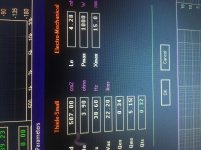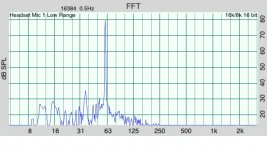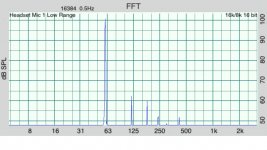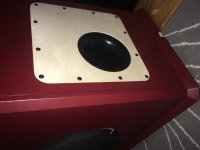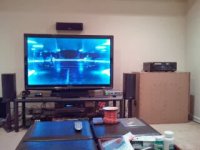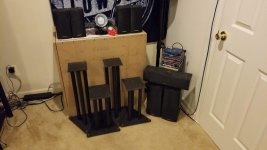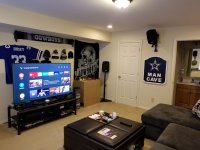The dIY diydgroup 12 is intersting. I put it a cabinet I know and the sound I get out of it with a driver slightly different in two main TS parameters (pic) but things aren’t as far off as they might look if I enlarge the driver location to keep Vas happy and I engage a method to create the inductance issue with my Le. neither are particularly acurate, but I’m not arguing that. I’m Saying we might be similar, as this is in a very taped pipe sort of horn thing.. yet I’m spoiled by it and it’s hard to sometimes choose what to do in other areas ? but I have tried, and some with horn, pipe or TL I’m a lot of ideas, but non in particular, Or best. Just many ...
Attachments
No, it’s the driver I have handy that’s similar in a few ways , but the larger Vas defines a need in sim that’s a large air mass into a smaller instead of of a long thin or consistent version of the same to get a similar result as response. Kind of. I have problem and it compounds an issue making my drivers Qes double nearly by horn response.... sim(inductance).
it’s hard to sim something because of the lossy inductance part of that sim. I m always looking for another 12 to replace this with, but only a handful have the motorforce, and not the inductance issues (B&C 12pg,tbx,nw100 and the Dayton rss315ho4) that I can find ..so far..
it’s hard to sim something because of the lossy inductance part of that sim. I m always looking for another 12 to replace this with, but only a handful have the motorforce, and not the inductance issues (B&C 12pg,tbx,nw100 and the Dayton rss315ho4) that I can find ..so far..
If a speaker moves, then it distorts. Sealed enclosures will have the most distortion of all the BOX designs. BP4/BP6's have the least distortion because the speaker moves less in a Sealed/BR/PR enclosure when given the same voltage. Also, the vents/ports/horns in BP4/BP6's filter out the speaker's mechanical noises.
@Fanatic Thanks for a very usefull post. I will share with my brother who is thinking of building his first subs
Cheers!
Cheers!
BP1Fanatic, I agree Mr. Klipsch proved the less cone movement the less distortion many years ago. However, there are large difference in drivers.
Also, that is good foreshadowing about the bp4. I plan to do a bandpass distortion test with some cheap 8" subs soon.
Also, that is good foreshadowing about the bp4. I plan to do a bandpass distortion test with some cheap 8" subs soon.
If a speaker moves, then it distorts. Sealed enclosures will have the most distortion of all the BOX designs. BP4/BP6's have the least distortion because the speaker moves less in a Sealed/BR/PR enclosure when given the same voltage. Also, the vents/ports/horns in BP4/BP6's filter out the speaker's mechanical noises.
Do they filter out the qw harmonic intervals or create way to use then to an advantage in folding lengths still? I trip and fall into the hole and start chasing so many things that I just toss a coin instead and use the convenient shape version. But that’s lame and I need to remember convenient isn’t learning...
Btw, what’s distortion?
Distortion is a sound error, sum of harmonics of a signal. For our interest on diyaudio, it's convenient to measure with REW. It's happen at a multiple of a frequency, and it's usually measured at a % of the produced input signal. It's increased a lot at long excursion of driver, when reaching xmax, hence, at really low frequencies, or high power.
The distortion produced for example for a 50hz signal on input, is so namely "H2" when at 100hz, "H3" when at 200hz...etc.
When applying acoustic filter with a bandpass chamber, the acoustic low pass formed, filters so this distortion produced before the chamber, hence, from drivers and amp, and even more for harmonics due to the slope of the low pass. But this do not come free, because port add their own noise, and compression at high air velocity, depending on frequency. So all that can be tuned by siming.
On the contrary, applying a electrical low pass, in electrical chain, before that the drivers produces it own distortion, does not reduce at all drivers induced harmonics.
But harmonics are not a bad thing. Lot of modern mastering use it in a good way. Since we almost ear nothing below 30 hz, our brain is used to interpret it from it 60hz harmonic. So to get most of a speaker, 60hz bump, and low passing before, may increase perceved bass. But too much, and we have to deal with group delay issues. It is well know from bass players, as the "missing fundamental". Bass amp are not reaching 30hz, but still, the low B (30hz) string sound really well. No real-life sound is pure sinewave. Our brain is well trained to it. Same as when you see a shadow, you know more or less where there's a object without seeing it, without even studying the geometry of the scene.
And we have to keep in mind that low content is omnidirectionnal, contrary to higher content. So, higher harmonics can be localized...if you can localize sinwave sound +/- < 150hz , that mean it's it harmonics that you localize.
There's so much to tell, and i explain (and understand) so bad ^^
The distortion produced for example for a 50hz signal on input, is so namely "H2" when at 100hz, "H3" when at 200hz...etc.
When applying acoustic filter with a bandpass chamber, the acoustic low pass formed, filters so this distortion produced before the chamber, hence, from drivers and amp, and even more for harmonics due to the slope of the low pass. But this do not come free, because port add their own noise, and compression at high air velocity, depending on frequency. So all that can be tuned by siming.
On the contrary, applying a electrical low pass, in electrical chain, before that the drivers produces it own distortion, does not reduce at all drivers induced harmonics.
But harmonics are not a bad thing. Lot of modern mastering use it in a good way. Since we almost ear nothing below 30 hz, our brain is used to interpret it from it 60hz harmonic. So to get most of a speaker, 60hz bump, and low passing before, may increase perceved bass. But too much, and we have to deal with group delay issues. It is well know from bass players, as the "missing fundamental". Bass amp are not reaching 30hz, but still, the low B (30hz) string sound really well. No real-life sound is pure sinewave. Our brain is well trained to it. Same as when you see a shadow, you know more or less where there's a object without seeing it, without even studying the geometry of the scene.
And we have to keep in mind that low content is omnidirectionnal, contrary to higher content. So, higher harmonics can be localized...if you can localize sinwave sound +/- < 150hz , that mean it's it harmonics that you localize.
There's so much to tell, and i explain (and understand) so bad ^^
Last edited:
Nope, not bad. and very helpful. I was trying to chase those in offset driver entries in TL, but then it became a different approach with an offset stub at the higher velocity area of the 3/4 or 5/4 harmonic and stuffed. in sim I chased it around but got lost too many times in the ‘tapped’ horn and trying to hit a dartboard with eyes crossed proved too tricky so I changed it into sonething entirely different. Which led to it becoming a qw pipe, and a boosted (tapped) amplifier(waveguide)... which is a can of worms itself and the rabbit hole is endless and impossible to satisfy it seems?
But thank you for that. It was refreshing! It was a carrot I needed (rabbit joke)😀
But I wanna break up my folding to promote the Fb, instead of random standing waves and a large mouth for them to get out and be audible or messy??
That 3x bass reflex or similar is quite handy in QW versions . the closer back BP model I think you spoke of? Kinda played with it with a tb w5 that I usually do that in a different way (front and back or driver
But thank you for that. It was refreshing! It was a carrot I needed (rabbit joke)😀
But I wanna break up my folding to promote the Fb, instead of random standing waves and a large mouth for them to get out and be audible or messy??
That 3x bass reflex or similar is quite handy in QW versions . the closer back BP model I think you spoke of? Kinda played with it with a tb w5 that I usually do that in a different way (front and back or driver
Last edited:
The next test is the diysg magnum 12 with 38hz port tuning. This required a little box surgery. The box originally had a 2.1 cu ft cavity and a .9 cu ft cavity for the plate amplifier.
I decided to cut two 7" holes in the board separating the two cavities. I now have a 3cu ft (85 liter) box. Reason for this is I had a an extra flared 4" pipe and the increased volume helped me a get tuning I was going for. My passive radiator has its weight glued in so I wasn't able to raise the tuning with that. I also plan to retest the radioshack 12" in the new larger volume.
Results for the diysg magnum in 85liters tuned to 38 hz were interesting. I thought I would enjoy the extra sensitivity in the 40hz-60hz range but instead my ear notices a timing issue. This could be because the group delay peak is pushed up to a more audible frequency (I'll post the hornresp group delay simulation later). Listening to Dancing in the Dark by Bruce Springsteen my feet where tapping along with the previous 60l passive setup but in this ported setup I found my self wondering why the kick drum sounded off.
Well enough blabber here is the max spl vs distortion test, lots of output near the tuning frequency as expected.
Frequency Spl of fundamental 2nd harmonic 3rd harmonic
16 60 -36 -20
20 68 -38 23
25 81 -30 -27
31.5 85 -21 -26
40 101 -25 -26
50 107 -27 -26
63 103 -24 -34
attached is 60hz @80db and 100db
I decided to cut two 7" holes in the board separating the two cavities. I now have a 3cu ft (85 liter) box. Reason for this is I had a an extra flared 4" pipe and the increased volume helped me a get tuning I was going for. My passive radiator has its weight glued in so I wasn't able to raise the tuning with that. I also plan to retest the radioshack 12" in the new larger volume.
Results for the diysg magnum in 85liters tuned to 38 hz were interesting. I thought I would enjoy the extra sensitivity in the 40hz-60hz range but instead my ear notices a timing issue. This could be because the group delay peak is pushed up to a more audible frequency (I'll post the hornresp group delay simulation later). Listening to Dancing in the Dark by Bruce Springsteen my feet where tapping along with the previous 60l passive setup but in this ported setup I found my self wondering why the kick drum sounded off.
Well enough blabber here is the max spl vs distortion test, lots of output near the tuning frequency as expected.
Frequency Spl of fundamental 2nd harmonic 3rd harmonic
16 60 -36 -20
20 68 -38 23
25 81 -30 -27
31.5 85 -21 -26
40 101 -25 -26
50 107 -27 -26
63 103 -24 -34
attached is 60hz @80db and 100db
Attachments
Last edited:
@Papasteak. Your last post means that a rapid drop below ex. 40hz is not noticeable if listening to rock with a 4 strin bass? - Unless its so loud you can feel the difference?
@Shcrub Thank you for interesting topic and sorry for participating in derailing 🙂
Cheers
@Shcrub Thank you for interesting topic and sorry for participating in derailing 🙂
Cheers
Missing fundamental, how higher serie of frequencies can sound lower pitch :
The Phenomenon of the Missing Fundamental - YouTube
11. The Missing Fundamental - YouTube
The most mind-blowing concept in music (Harmonic Series) - YouTube
That is why i don't like adding random harmonics related to speakers activity. It add harmonics to harmonics already comming from sources, and it involve for our brain harder efforts reconizing pitches.
The Phenomenon of the Missing Fundamental - YouTube
11. The Missing Fundamental - YouTube
The most mind-blowing concept in music (Harmonic Series) - YouTube
That is why i don't like adding random harmonics related to speakers activity. It add harmonics to harmonics already comming from sources, and it involve for our brain harder efforts reconizing pitches.
Last edited:
Excellent explanation papasteack!
All I know is there is a different sound that my ears like when low frequencies are coming from a vent/port/horn than a direct radiator. And, it doesn't take a lot of power to do so.
I have the least efficient TH (negative flare) design in my HTS. I cracked walls on multiple floors in my house with an old Yamaha HTR-5730 (100w x 2) running in stereo mode to a Kicker 08S15L74 DVC sub. You are not doing that with a single 15 in a sealed enclosure with 200w.
I upgraded to the Dayton Audio SA1000 amp because the Yamaha would cut out at my preferred movie watching volume (30 on the Sony STR-DN1080) when Kylo Ren used the force in Star Wars The Force Awakens.
All I know is there is a different sound that my ears like when low frequencies are coming from a vent/port/horn than a direct radiator. And, it doesn't take a lot of power to do so.
I have the least efficient TH (negative flare) design in my HTS. I cracked walls on multiple floors in my house with an old Yamaha HTR-5730 (100w x 2) running in stereo mode to a Kicker 08S15L74 DVC sub. You are not doing that with a single 15 in a sealed enclosure with 200w.
I upgraded to the Dayton Audio SA1000 amp because the Yamaha would cut out at my preferred movie watching volume (30 on the Sony STR-DN1080) when Kylo Ren used the force in Star Wars The Force Awakens.
Last edited:
Just checked, the Sony STR-DN1080 maximum volume is 74. I think the highest I ever had it is 35-40 during the last 2 New Year's Eve with my son and his friends.
So, if I followed this for 6 pages, the simple answer is to get busy converting my Dayton Titanic to a BP4.
bp1fanatic, do you have a hornresp model of your tapped horn home theater sub? I'm also a fan of horns. I've got two designed by BFM in my living room.
I've only heard the awful bandpass car subs, I'm keeping an open mind on bandpass though till I hear one with a less peaky response.
I've only heard the awful bandpass car subs, I'm keeping an open mind on bandpass though till I hear one with a less peaky response.
- Home
- Loudspeakers
- Subwoofers
- A tale of 12" subwoofers, distortion and 15 dollars.
